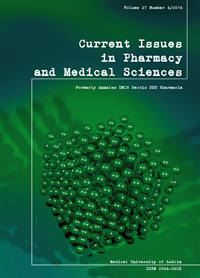The hepatoprotective activity of the herbal preparation Salivin against carbon tetrachloride (Ccl4) induced hepatotoxicity in rabbits
DOI:
https://doi.org/10.1515/cipms-2015-0030Keywords:
salivin, carbon tetrachloride, hepatoprotective activityAbstract
Recently, a trend has developed towards employing certain herbal medicines to manage hepatotoxicity. The present study is that of an assessment of the efficacy of a herbal preparation of Salivin (HPS), a combination of the herbs of Saussurea amara (L.)DC., Salsola collina Pall., Achillea asiatica Serg. and rhizomes of Glycyrrhiza uralensis Fisch, in rabbit models, against CCl4-induced hepatic damage. In so doing, an extract of HPS (200 mg/kg body weight/day), along with reference control tablets of Carsil (Silymarin 35 mg) (250 mg/kg body weight/day) (which is known for its hepatoprotective effects) were administered, along with the standard diet.
The experimental group of rabbits received HPS orally for 28 days, which resulted in a decrease in blood enzymes (aspartate aminotransferase, alanine aminotransferase, alkaline phosphatase), compared to the control.
Evidenced by biochemical and histopathological studies, it is concluded that the polyherbal formulation HPS showed hepatoprotective activity against induced CCl4 hepatotoxicity in rabbits.
References
1. Daariimaa Kh. The phytochemical study of Saussurea amara (L.) DC. Ph.D dissertation, 2006; Ulaanbaatar.
2. Feroz Z, Khan RA, Amber, Mahayrookh. Hepatoprotective effect of a herbal drug on CCl4 induced liver damage. Pak J Pharm Sci. 2013 Jan; 26 (1): 99-103.
3. Glasl S, et al. Choleretic effects of the Mongolian medicinal plant Saussurea amara (L.) in the isolated perfused rat liver. J.Planta Med. 2007; 73 (1): 59-66.
4. Gowri ShNL. Manavalan R, Venkapaya D, David Raj. Hepatoprotective and antioxidant effects of Commiphora berryi (Arn) Engl bark extract against CCl4-induced oxidative damage in rats. Food Chem Toxicol. 2008; 46 (9): 3182-3185.
5. Houari S, Naboka OI, Glushchenko AV. Influence of extractions of Ruta, Artichoke, Bupleurum and Salsola collina upon the indexes of peroxidation of rats lipids, on against a background of ССL4 action: actual questions of development of new drugs. Book of abstracts of XX international scientific and practical conference of young scientists and students, devoted to the 90th anniversary of Doctor of Science in pharmacy, Professor Dmitri Pavlovych Salo, 2013: 25-26.
6. Ligaa U. Medicinal plants of Mongolia used in Mongolian traditional medicine. Korea: KCA Press; 1996: 333-334.
7. Niazmand S, Khooshnood E, Derakhshan M. Effects of Achillea wilhelmsii on rat gastric acid output, at basal, vagotomized, and vagal-stimulated conditions. Phcog Mag. 2010; 6: 282-285.
8. Nikiforov S B, Semenov AA, Syrchina AI. Effect of the aqueous extract of the aboveground parts of Salsola collina Pall on the distribution of cholesterol in blood serum lipoprotein fractions, in rabbits with experimental cholelithiasis. Khimiko-Farmatsevticheskii Zhurnal. 2012; 36 (10): 27-28.
9. Palanisamy D, Syamala, Kannan E, Bhojraj S. Protective and therapeutic effects of the Indian medicinal plant Pterocarpus santalinus, on D-galactosamine-induced liver damage. Asian Journal of Traditional Medicine. 2007; 2: 51-57.
10. Pitschmann A, et al. Traditional Mongolian Medicine history and status quo. Phytochemistry Reviews. 2013; 12(4): 943-959.
11. Rahmat A Khan, et al. Hepatoprotective activity of Sonchus asper against carbon tetrachloride-induced injuries in male rats. BMC Complement Altern Med. 2012; 12: 90.
12. Recknagel RO. Carbon tetrachloride hepatotoxicity. Pharmacol Rev, 1967; 19: 145-195.
13. Recknagel RO, Glende EA, Dolak JA, Waller RL. Mechanism of carbon tetrachloride toxicity. Pharmacol Ther. 1989; 43: 139-154.
14. Saeidnia S, Gohari AR, Kiuchi F. A review on the phytochemistry and medicinal properties of the genus Achillea. Daru. 2011;19 (3): 173-186.
15. Saratikov AS, et al. Hepatoprotective properties of a lokhein extract from Salsola collina Pall. Rastitel nye Resursy. 2004; 40 (2): 133-138.
16. Shim SB, Kim NJ, Kim DH. Beta-glucuronidase inhibitory activity and hepatoprotective effect of 18 beta-glycyrrhetinic acid, from the rhizomes of Glycyrrhiza uralensis. Planta Med. 2000; 66: 40-43.
17. Tseden P. The pharmacological study of Salsola collina Pall. Ph.D dissertation, 1998; Ulaanbaatar.
18. Vengerovskii AI, Chucholin VS, Sadykh LM. Hepatoprotective properties of an extract from the above ground part of Salsola collina Pall. J.Rastitel Nye Resursy. 1989; 25 (4): 575-580.
19. Wang W, et al. Glycyrrhizic acid nanoparticles inhibit LPS-induced inflammatory mediators in 264.7 mouse macrophages, compared with unprocessed glycyrrhizic acid. International Journal of Nanomedicine. 2013; 8: 1377-1383.
20. Xiang Y, et al. A new alkaloid from Salsola collina. Yao Xue Xue Bao. 2007; 42 (6): 618-620.
21. Zhao YX, Ding XB. Studies on the alkaloids from Salsola collina Pall. Yao Xue Xue Bao. 2004; 39 (8): 598-600.
22. Zhang Q. Chemical analysis of the Chinese herbal medicine Gan-Cao (licorice). J Chromatogr. 2009; 13; 1216 (11): 1954-1969.
23. Zidan A, Scheuerlein H, Schule S. Epidemiological pattern of hepatitis B and C as etiological agents for hepatocellular carcinoma in Iran and worldwide. Hepat Mon., 2012; 12 (10): 684-688.
Downloads
Published
Issue
Section
License
Copyright (c) 2015 Authors

This work is licensed under a Creative Commons Attribution-NonCommercial-NoDerivatives 3.0 Unported License.


